#guandi
Photo

“Altar in the Chinese Joss-house, San Francisco. A probable illustration of Eastern Glory Temple from Harper’s Weekly, March 25, 1871.
The Eastern Glory Temple of Dupont Street
The “Eastern Glory” Temple (東華廟; canto: “Doong Wah miu;” pinyin: “Donghua miao”) reportedly opened in 1871 possibly at 929 Dupont Street. The Daily Alta California of February 10, 1871, reported that a temple “just completed by the six companies” was located in the third story of a row of buildings “on the west side of Dupont street on the west side of Dupont street, between Washington and Jackson.”
The reporter who had been invited to the inaugural rites at the new temple observed that the temple’s central hall honored “Pak Tie,” one of three gods whose statues were so honored. The temple also venerated in its center hall, Gwan Dai (關帝; pinyin: “Guāndì”), the God of War, and Hung Sing, the God of Water. Other deities were venerated in side rooms.




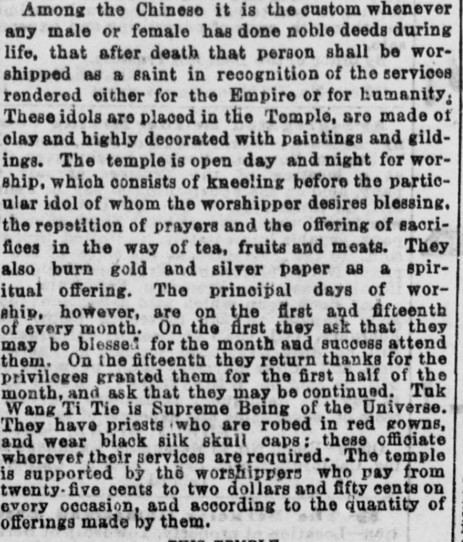



Less than a month later, the Daily Alta California on May 1, 1871, printed a critical letter to the editors from a reader, pointing out numerous inaccuracies in the previous news report. This letter contains the first reference to the temple as the “Tung Wah Min” in reference to its origins in southern China and, perhaps more significant, the poetic inscription which referred to the waves of blessing flowing to the men of eastern Cantonese men. The letter then described the temple’s veneration of “Pak Tie” (北帝; lit. "North Deity;" canto: “Buck Dai”), also known as the “God of the Eastern Peak.”

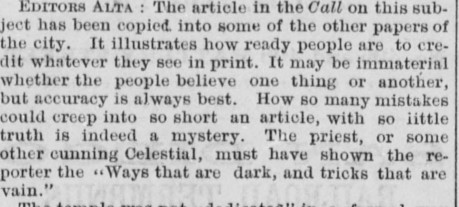






In his superb mapping project of the temples of old San Francisco Chinatown (found here), Peter Romaskiewicz asserts that pioneer photographer Eadweard Muybridge’s photograph “843 -- Chinese Joss House, Guardian of the Temple” c. 1871 was taken in the Eastern Glory Temple. The altar or central shrine shown in the photograph is consistent with the newspaper descriptions.

“843 – Chinese Joss House, Guardian of the Temple” c. 1871 - 1875. Photo by Eadweard Muybridge (from a private collection). The stereograph shows an altar in a temple that is probably the Tung Wah Miu (東華廟; canto: “Doong Wah miu;” pinyin: “Donghua miao”) or the “Eastern Glory” temple to non-Chinese.
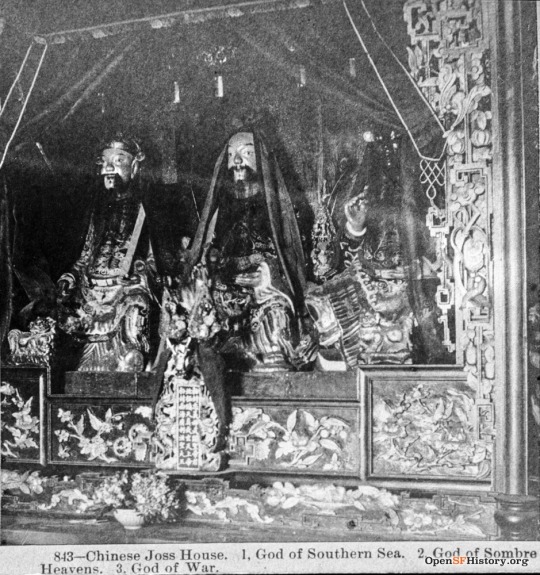
“843 – Chinese Joss House. 1, God of Southern Sea. 2, God of Sombre Heavens. 3. God of War” Detail of the altar of the Eastern Glory Temple, c.1871 - 1875, detail from a photo by Eadweard Muybridge (from the Marilyn Blaisdell collection). In Chinese, the God of Southern Sea would be 南海洪聖大王, Sombre Heaven is 玄武(or 真武)大帝, and the God of War is often ascribed to 關公 (canto: “Gwan Gung”).
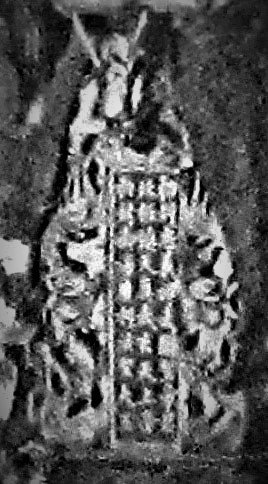
The plaque seen in the Muybridge photo no. 843 presents deity names including “Pak Tie” (canto: “Buk Dai;” pinyin: “Beidi”).
As was the case of Chinatown’s other pre-1906 temples, the Eastern Glory temple was known for its elaborate ceremonies and festivals, which attracted Chinese immigrants from all over San Francisco and beyond. During these events, the temple would be filled with the sounds of traditional Chinese music and the smell of incense, as worshippers prayed and made offerings to the gods.
Assuming that Romaskiewicz accurately located Muybridge’s altar idols image no. 843, the numerical sequence of Muybridge’s other temple images indicates that Muybridge took at least two (and possibly three) photos before entering the Eastern Glory Temple and several other photographs at the same location after capturing image no. 843.
Two photos, 840 and 841, of “menshen” or door gods (文門神; canto: “munh moon sun”) have survived in various public and private collections. The door gods are usually presented in divine pairs, or Shenshu (Chinese: 神荼; Jyutping: “San4 Tou4″).

“840 – Chinese Joss House, Guardian of the Temple” c. 1871. Photo by Eadweard Muybridge (from the Marilyn Blaisdell collection and a stereoview titled “Guardian of the Door” in the collection of California State Library). Based on the negative no. 840, Muybridge probably took this photo of the other entry door to the Eastern Glory Temple before photographing the altar idols and door seen in his images no. 841 and 843. The guardian seen in this image is Shubao (叔寶; canto: “Sook Boh”) , one of two Tang dynasty generals whose image was ordered placed upon gates by the Great Ancestor of the Tang (“Emperor Taizong”).
Since the Tang dynasty, the deified generals Qin Shubao (Chinese: 秦叔寶; Jyutping: “Ceon4 Suk1 Bou2”) and Yuchi Gong (Chinese: 尉遲恭; Jyutping: “Wai3 Ci4 Gung1”) became most ubiquitous as martial door gods (武門神; canto: “moe munh sun;” lit. “military gate gods”). Moreover, the first Chinese in California identified often referred to themselves as “Tohng yahn” (lit. “Tang dynasty people”).

“841 – Chinese Joss House, Guardian of the Temple” c. 1871. Photo by Eadweard Muybridge published as a stereograph by Bradley & Rulofson (from the collection of the Getty Museum). Based on the “841” number, it can be inferred that Muybridge probably took this photo before entering the Eastern Glory Temple and photographing the altar idols seen in his image no. 843. The guardian seen in this image is Yuchi Gong(尉遲恭; canto: “Gwai Chee Gung”), one of two Tang dynasty generals whose image was ordered placed upon gates by the Great Ancestor of the Tang (“Emperor Taizong”).
Based on a comparison of the numerical labeling of the images, and a comparison of the partial signage seen in Muybridge’s photo no. 843, it is possible to connect several images taken of the temple’s resident priest(s) and astrologer outside the entrance.

“844 – Chinese Joss House. Tanist [sic] Priest in full costome.” Photographer Eadweard Muybridge (from the collection of the California State Library).

“Chinese Joss House, Tauist [sic] Priest In Full Costume” c. 1875 (from the collections of the Bancroft Library).

“845 - Chinese Joss House, Astrological Priest”(from the collection of the New York Public Library). This photo appears to have been taken in front of the same building as the photo no. 842 of the Taoist priest.

“846 – Chinese Joss House, Priests discussing Theology.”

“847 – Chinese Joss House. God of the Earth.”
Muybridge’s dogged persistence, and the apparent cooperation of the temple staff, produced an extant photographic record of the Eastern Glory temple provides perhaps the best documentation of the pre-1906 temples in San Francisco Chinatown.
Despite the challenges faced by the Chinese community in San Francisco, including discrimination, poverty, and violence, the Eastern Glory Temple remained a source of strength and resilience. It provided a sense of belonging and identity for the community, and helped to preserve traditional Chinese culture and beliefs in a foreign land.
However, the temple’s days came to an abrupt end in 1906, when a massive earthquake struck San Francisco and destroyed much of Chinatown. The Eastern Glory Temple was among the many buildings that were destroyed in the disaster. Despite its relatively short existence, the Eastern Glory Temple remains an important symbol of the resilience and perseverance of the Chinese community in San Francisco. Today, its legacy lives on through the many temples and cultural institutions that continue to thrive in Chinatown and beyond.
[updated: 2024-5-5]
#Eastern Glory Temple#929 Dupont St.#San Francisco Chinatown#Chinese joss house#Eadweard Muybridge#Beidi#Guandi#Daily Alta California#door gods#Qin Shubao#Yuchi Gong
2 notes
·
View notes
Text
reading ovid's metamorphoses for the first time & losing my mind every time something takes place in a 'forest that has never been cut'
14 notes
·
View notes
Text
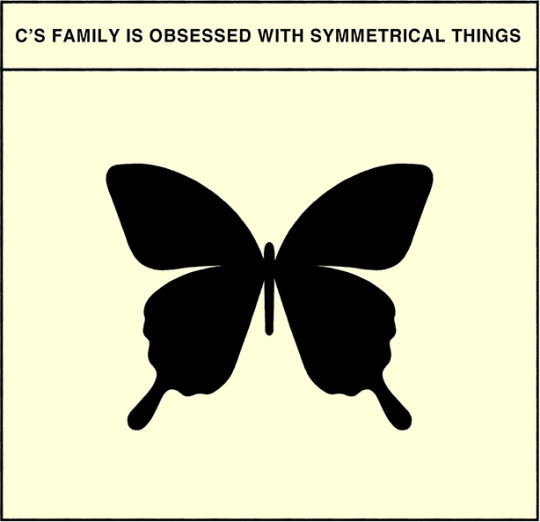



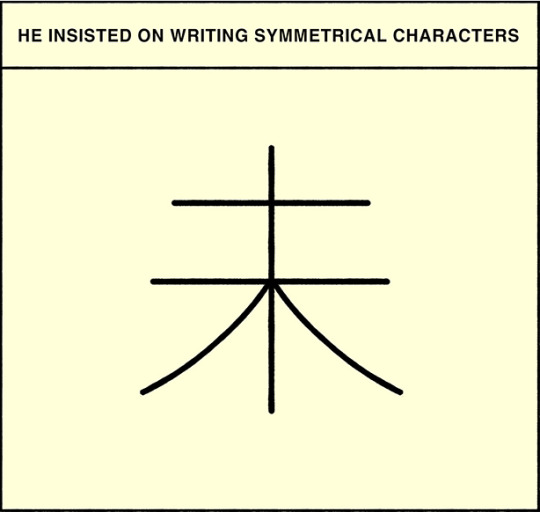

















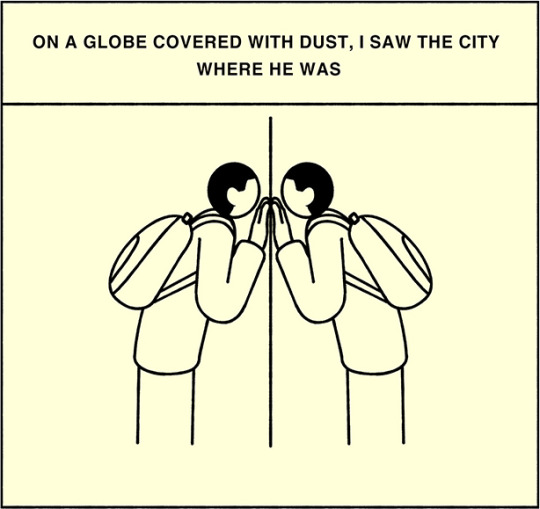

对称
Symmetry
Translated by Guandi Wu( @sarah.guandiwu )
原载于三联《少年》杂志,谢谢编辑田克。
11K notes
·
View notes
Text










Homelike Ambience in the Martial Deity Temple
Unexpectedly stunning architecture of the rural Guandi temple (關帝廟), the largest in the Chinese countryside. During heat waves, the elderly uses its huge lobby to relax and socialize. Like many rural temples, this one is distinguished by a special homelike heartiness.
Located in Qiangxia village (牆下村), Xia county, Yuncheng, Shanxi, the temple was built to honor Guan Yu during the Yuan dynasty, but evolved and expanded many times in the subsequent Ming and Qing eras.
Originally Marquis Zhuangmou (壯繆侯), Guan Yu in Chinese folk religion achieved the status of Emperor Guan (Guandi 關帝) over the centuries. By the Sui dynasty (581–618), he was officially deified and became part of the motley pantheon as a martial god. Later, the cult of Guan Yu reached the international level and can now be traced in Vietnam, Korea, Singapore, and Japan.
Photo: ©大梁趙孟橘
#ancient china#chinese culture#chinese architecture#guan yu#qing dynasty#yuan dynasty#ming dynasty#wooden architecture#wooden buildings#wooden interior#old china#chinese customs#taoism#taoist#chinese folk religion#chinese temple#religious art#temple architecture#countryside#wood aesthetic#wood art
92 notes
·
View notes
Photo
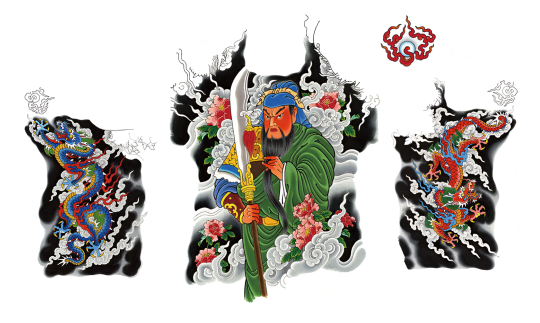
李文海, Lee Wen Hai
関羽と龍 - Guan Yu and Dragons
Type: Full
Note: Lee's back and chest tattoo sections are never revealed in game. Only the two dragons are ever fully visable, though in the mahjong parlor the edge of the pearl on his chest can be seen.
Features:
Guan Yu - Also known as Guandi, Guan Gong, or Wudi. A Chinese historical figure who was canonized as a god of war during the Ming dynasty. He appears as a character in the famous Chinese novel "Romance of the Three Kingdoms." He is a heroic figure, whose control over evil spirits is so great that it is believed even actors who play his part in dramas share his power over demons.
One of China’s best-known stories tells how he became one of the Three Brothers of the Peach Orchard. Liu Bei, a maker of straw sandals, intervened in a fight that was brewing between Guan Yu and a prosperous butcher named Zhang Fei. The three became friends and swore oaths of undying loyalty that they faithfully observed until death.
Another story tells of Guan Yu coming to the rescue of a young girl abducted by a magistrate. Guan Yu killed the man and after fleeing for his life, came upon a guarded barrier. Suddenly his face changed to a reddish hue, and Guan Yu was able to pass unrecognized. He is often depicted with red skin in reference to this story.
Imperial Dragons - Eastern dragons are powerful and fearsome, but mostly benevolent creatures known to protect temples and help and reward virtuous people. In China, they are associated with the element of wood, but also control weather and water.
The Imperial Chinese Dragon is identifiable by its 5-clawed feet (as opposed to the normal Chinese dragon's 4 claws or Japanese 3 claws). Dragons represent the emperor and how a good ruler must be just and look out for the good of their subjects.
Red - energy, vitality, heat, and power. In China red is a lucky color associated with happiness, celebration and fertility. It is the color of the fire element, and is said to ward off evil.
Blue - calmness, stability, purity, cleanliness, passivity and fidelity. In China Blue is associated with the wood element and also symbolizes spring, immortality and advancement. The Blue/Azure dragon is the ruler of the eastern sky in both Japan and China.
Pearl - Eastern Dragons are often depicted carrying a pearl, sometimes clutched in its claws or beneath the neck. While the exact origin of the pearl is unknown, it has come to represent the dragon’s authority, the moon, the sun, and control of water.
Peonies - good fortune, wealth, nobility, bravery, and honor. Red peonies are associated with Imperial China and signify authority.
Clouds - The heavens, the realm of the gods and admiration of nature.
Flames - Passion, Energy, desire, movement
#wen hai lee#yakuza#ryu ga gotoku#yakuza games#yakuza 0#tattoos#irezumi#dragon#peonies#clouds#flames#guan yu#like a dragon
53 notes
·
View notes
Text
Pemkot Bengkulu Imbau Warga dalam Menghadapi Peningkatan Kasus DBD di Musim Pancaroba
Pemkot Bengkulu Imbau Warga dalam Menghadapi Peningkatan Kasus DBD di Musim Pancaroba
KOTA BENGKULU – KANTOR-BERITA.COM|| Memasuki musim pancaroba dengan tingkat kelembaban udara yang tinggi, masyarakat dihadapkan pada tantangan kesehatan yang serius, yakni peningkatan kasus demam berdarah dengue (DBD). Oleh karena itu, Pj Walikota Bengkulu, Arif Guandi, mengajak masyarakat untuk proaktif…

View On WordPress
0 notes
Text
animals + werewolf forenames
Aara Adale Adgant Adog Adolf Adruse Alladdolf Alownflyka Alupio Alwolph Amahipe Aman Ameep Ameet Amse Amulla Amwhillift Anaccorto Anaiyuk Anak Andendsh Andsh Angon Annermite Anun Aphamst Apireift Apirhipmu Aran Aribbirie Aroost Asperhel Audin Audo Aulf Aull Babbish Bachippe Backombat Balle Banno Bard Bark Barwi Basink Batel Batfis Batter Beadolf Bedilvay Beelo Beer Beopper Birra Bish Bishak Blab Blackbilks Blampranda Bled Blesnale Bluew Bluposanti Boadonito Boat Bobou Bodpelf Bodwolf Bonitcrog Boodper Boonk Bothog Botwomono Bouse Calimardog Calusefox Canat Canden Capercupus Carne Catercant Catfishawk Cenguit Chaliboal Chalph Chamai Chan Chanako Chic Chicowel Chidormago Chingrik Chiperch Chiperfin Clardwork Cloug Coce Cock Coctounk Coder Codig Codilly Coding Codolf Coher Conow Cony Crackpanet Crayindi Cric Criconipe Damse Deet Dolf Dolfow Dolphele Dormotorse Dover Dowlarose Duca Duwulris Eafowl Earm Easirog Eckwharree Eelfa Egan Eganaill Egangon Elab Eleowl Emurtork Etle Eyote Fark Fengan Firey Fishopus Fisk Flyalcoh Flybasilk Fraandolf Frie Frodil Galph Gamoheer Gandilver Gatfis Gian Giantel Giboa Gibutat Gire Girhear Giryuk Goadil Golf Gook Goolf Gran Gride Gridgeret Grin Grodwoo Groo Guadal Guaillampe Guandi Guangbeas Guar Guark Guaroadow Guiddyn Guiralook Guirher Guite Guitolfer Gundin Gutamulver Hakeetle Halein Halis Hamerm Hamolf Hanarog Hande Hawn Hedger Hele Helwul Herk Honkey Hrekinkey Hrou Hrudi Hrus Hrusil Humpan Humpbadi Huse Hyend Hyenrin Igard Indaleasp Ingrider Innockas Jacan Jagane Jayfirren Jelan Jell Kingareift Kingor Koish Kook Krich Kroug Lach Lante Laterog Leet Leid Lemmahaman Lepher Liona Liondsh Lluper Lockbird Loppo Lotworse Loupigulve Lowl Luew Luewhal Lugalug Lupum Lusi Maclaik Maclan Maen Magazeelow Maguin Mahaw Mahipe Male Malifow Mamse Manacudon Mand Mandslupor Mardvard Mark Maroux Measpan Meat Mefly Melimpbalo Merbilk Mineadil Ming Mingma Minguana Minguk Minolf Mitcrook Moce Mocupuse Mohel Molf Molfe Monit Monow Moolf Moos Moseater Mostam Mothon Moule Moun Mounkeyly Mulf Muregroule Nackinder Nipecket Nitor Nule Olpant Osal Oseas Pacupe Panhalco Panhallaby Pardfis Parkadolf Parmouse Parp Pech Pedigeon Perse Pheddybuff Phee Pigeif Piguan Pingbite Piragony Plamper Poish Poishrepha Ponk Popopost Poray Prab Prantewhan Pratfis Prebra Primpie Pumad Pybuzzlyn Quan Quid Raboon Rail Ranak Ranger Rantheark Rantle Ranturtig Rassharie Rayloboter Rayly Redeet Regroa Relvele Rhall Rhede Rhigerick Rhimar Rhine Rhiperfish Roatormoux Roupu Rowl Rudolf Ruseaddyn Saulmadog Shante Shar Sine Sinefow Singundolf Sira Sirdwolf Skiwid Sköllandal Sloutterm Slow Slowelan Snach Snaileowl Snalest Spid Spie Squanda Squin Squitbat Stelfale Ster Stoi Sumacoolf Sumpan Swailderm Swall Swaslo Swig Swolfe Tais Tale Tallatewt Tchic Tcroth Theer Tingun Toatrocent Tolfo Toparkere Tortig Toularwill Tringat Troaca Trog Trolfo Troondgerm Troste Tull Turk Tyrande Udola Ullo Ulman Ulrundale Ultulfroon Uwan Uwulf Vamel Vele Vilk Vill Vipmus Vule Waikey Wailla Wairher Wala Walic Walimp Wall Wallamu Walothrowl Wassustoug Welandowl Wele Welf Whamunke Wharbird Wharow Whartleow Widuck Wift Wige Wiledpela Wole Wolfard Wolflynx Wolph Wolphaner Womodolf Womotwolph Wook Word Work Worm Wulf Yaligell Zeest
0 notes
Photo

Bonne fête à toute la communauté chinoise ✨️🌞🌻 Guandi ou Kuan-Ti est le dieu de la guerre et le protecteur de la littérature qui acquit une telle célébrité par ses prouesses guerrières et fut ensuite vénéré comme un dieu. Guandi est divinité taoïste protectrice des soldats et des policiers. Il a été érigé en modèle de vertu par le confucianisme protecteur du royaume. https://www.instagram.com/p/CgTC9ZGooyx5tPBaXlfNkf1izqxEf46lmrusdQ0/?igshid=NGJjMDIxMWI=
0 notes
Photo

A time ago, at Guandi celebration with @118elodie #sky #cloud #tree #green #red #guandi #natural #nature #naturephotography (à Saint-Denis, Reunion) https://www.instagram.com/p/B6PhNpqlXy6/?igshid=9nyxvsb1m35k
1 note
·
View note
Photo

Statuette of Guandi. From life
~~~
Статуэтка Гуань-ди. С натуры
youtube
#art#artists on tumblr#drawing#painting#digital painting#from life#statuette#Guandi#Guan Yu#Guan Gong#Kuan Ti#Wudi#still life#Chinese#關羽#关羽#рисунок#живопись#искусство#цифровая живопись#натюрморт#с натуры#статуэтка#Гуань-ди#Гуань Юй#photoshop
7 notes
·
View notes
Photo

Door decoration at the Guan Di temple on #jalantunhslee #kualalumpur #chinatownkl #guanditemple #guandi #guanyu #guangong #guangongtemple
1 note
·
View note
Photo

🎋🧧 HAPPY CHINESE NEW YEAR 🧧🎋 ° ° ° Over the past few years, I have been fortunate enough to make many friends in East Asia. Speaking with them has made the celebration of Chinese New Year that much more vibrant and exciting. I love what the holiday represents, and I am grateful to live in a time when cross-continental friendships are so possible! 🎊 ° ° ° So, Happy Chinese New Year, 2020!!! Year of the Rat!! 🐭🐁 ° ° ° Alas, this photo was not taken in China (I have not been there - yet), but it was taken in Asia, and features the beautiful Guan Di Temple (also known as Kuan Ti Temple), a Taoist temple built in 1888. ° ° ° ° ° #Travel #Wanderlust #Location #destination #Views #Vacation #KualaLumpur #Malaysia #ChineseNewYear #chinesenewyear2020 #Taoist #TaoistTemple #GuanDi #ChinaTown #RedLantern #GoldenDragon #China #ChineseArt #SouthEastAsia #Architecture #ArchitecturePorn #aesthetic #TravelPhotography #ProfesionalTourist #PhotoOfTheDay #FemmeTravel #SheIsNotLost #TravelMore #GirlAroundWorld #CoffeeOnAPlane (at Guandi Temple, Chinatown KL) https://www.instagram.com/p/B7vQIfAhFGC/?igshid=gvb1x7ps1lua
#travel#wanderlust#location#destination#views#vacation#kualalumpur#malaysia#chinesenewyear#chinesenewyear2020#taoist#taoisttemple#guandi#chinatown#redlantern#goldendragon#china#chineseart#southeastasia#architecture#architectureporn#aesthetic#travelphotography#profesionaltourist#photooftheday#femmetravel#sheisnotlost#travelmore#girlaroundworld#coffeeonaplane
0 notes
Text





影子
Shadow
Translated by Guandi Wu
5K notes
·
View notes
Text
Guandi has two moods: 1- absolutely feral 2- "I love my gf so fucking much guys"
1 note
·
View note
Text
References
High Quality Tattoo Scans
https://tarokro.tumblr.com/post/653991776143720448/yakuza-characters-tattoos-from-the-yakuza-15th
Cleaned Tattoo Images and Translated Titles
https://azureseadragon.tumblr.com/post/684263930881802240/masterlist-yakuza-series-tattoos-15th
Name Meanings
https://www.tumblr.com/dorkydragon
Shinto, Buddhism, and Myth
https://www.onmarkproductions.com/html/buddhism.shtml
https://www.nichirenlibrary.org/en/
https://yokai.com/
Japanese Tattoo Terminology
https://www.bardadim.tattoo/tattoo/style/
Flower Information (jfc send help finding reliable sources)
https://www.atozflowers.com/flower/epiphyllum/
http://www.efloras.org/florataxon.aspx?flora_id=2&taxon_id=200027121
Misc Japanese Tattoo info
https://www.bkktattoostudio13.com/japanese-koi-fish-tattoo-meaning.html
https://www.bkktattoostudio13.com/japanese-tattoo-flowers-meaning.html
https://www.bkktattoostudio13.com/japanese-tattoo-dragon-ryu-meaning.html
Western Tattoo info
https://www.cloakanddaggerlondon.co.uk/
Horitomo’s comments translated
http://fftranslations.atspace.co.uk/rtz/horitomo.html
Shisa
https://web.archive.org/web/20111009090558/http://www.okiken.com/modules/tinyd0/index.php?id=2
https://web.archive.org/web/20091009064358/http://www.wonder-okinawa.jp/011/english/roots/world/rw01/rw01.html
Bats
https://www.batcon.org/article/bat-myths-of-japan/
https://www.batcon.org/article/bats-in-chinese-art/
Momotaro
https://books.google.com/books?id=2r9DDwAAQBAJ&pg=PA251#v=onepage&q&f=false
https://etc.usf.edu/lit2go/72/japanese-fairy-tales/4845/momotaro-or-the-story-of-the-son-of-a-peach/
Benzaiten
https://www.britannica.com/topic/Benten
Snakes
https://www.researchgate.net/publication/228899523_Endangered_Traditional_Beliefs_in_Japan_Influences_on_Snake_Conservation
https://www.atlasobscura.com/foods/habushu-habu-sake
Hannya Mask
http://www.historyofmasks.net/famous-masks/hannya/
Color
https://www.japan-academy.in/blog/colors-in-japanese/
https://www.color-meanings.com/color-symbolism-in-chinese-culture-what-do-traditional-chinese-colors-mean/
Kirin/Qilin and the 4 Auspicious Beasts
https://english.visitbeijing.com.cn/article/47OLU38nt7x
Guan Yu
https://www.britannica.com/topic/Guandi
Ox-Head & Horse-Face
http://people.reed.edu/~brashiek/scrolls/seriesA/common/oxandhorse.html
Okame
https://traditionalkyoto.com/culture/figures/otafuku/
https://www.britishmuseum.org/collection/term/BIOG4628
Cranes
https://www.kyuhoshi.com/tsuru-no-ongaeshi/
https://www.nps.gov/articles/000/the-story-of-sadako-sasaki.htm
Hakutaku
https://www.britishmuseum.org/collection/term/BIOG229174
Sanskrit
https://www.wisdomlib.org
Mahabali
http://www.onamfestival.org/king-mahabali-onam.html
Yellow Dragon and Other Dragons of China
http://www.chinadaily.com.cn/a/201411/14/WS5a2a34aea3101a51ddf8f70a.html
Huangdi
https://www.britannica.com/topic/Huangdi
Shirohebi White Snake
http://kankou.iwakuni-city.net/itn/natural-treasure-white-snakes-of-iwakuni
20 notes
·
View notes
Video
<strong>Figur des Kriegs- und Reichtumsgottes Guandi (Figure of the God of War and Wealth) <a href="https://www.flickr.com/photos/hen-magonza/">by HEN-Magonza</a></strong>
Figur des Kriegs- und Reichtumsgottes Guandi Polychrom glasiertes Steinzeug China, Ming-Dynastie, 16. Jh. n. Chr.
Figure of the God of War and Wealth Stoneware with polycrhome glaze Chine, Ming Dynasty, 16the century AC
#Liebieghaus#Frankfurt#Hessen#Hesse#Deutschland#chinesische Kunst#Chinese Art#Gott Guandi#God Guandi#Frankfurt am Main
2 notes
·
View notes
